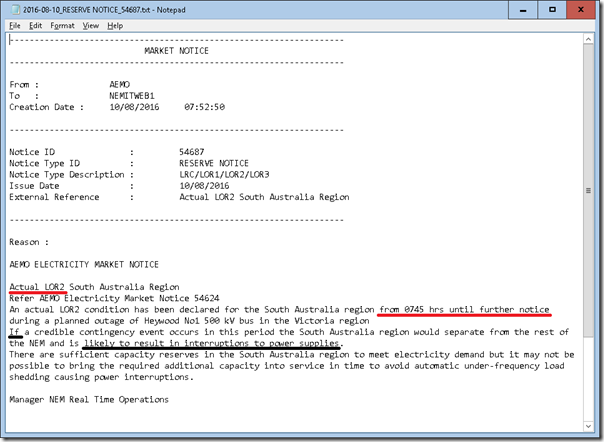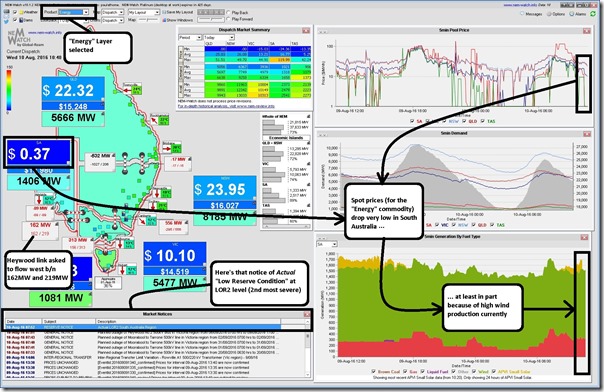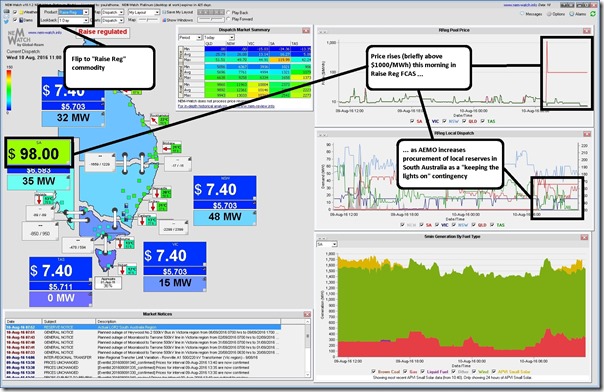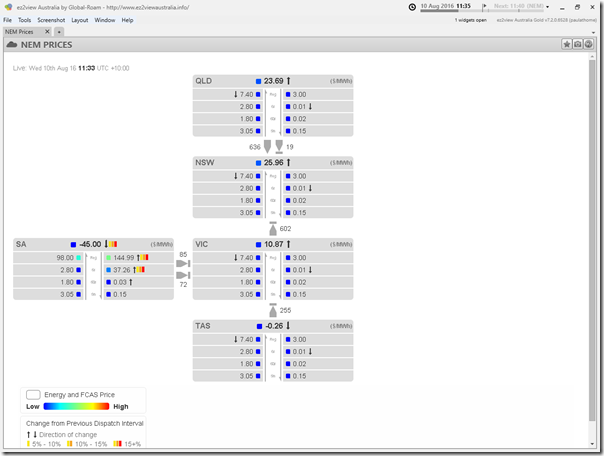A NEM-Watch SMS alert this morning made me aware of the fact that AEMO had issued a Market Notice (at 07:52) notifying market participants (and a diverse range of interested spectators like us) about the heightened risk that our South Australian friends face today as a result of a number of factors, including some of the longer list identified here a couple weeks ago.
Details of the market notice are recorded here, for ease of reference:
The key text being as follows:
“If a credible contingency event occurs in this period the South Australia region would separate from the rest of the NEM and is likely to result in interruptions to power supplies.”
In shorthand, this means that if something happens (like the critical imports from Victoria tripping – a low probability event, but still a credible one, and so one AEMO needs to plan for) then South Australia would not have enough local supplies that could be dispatched in time to keep the SA system stable, so portion of SA load would be turned off (i.e. some lights would go out) to keep the broader system in South Australia online.
Looking at the Energy Layer (i.e. the default one) within NEM-Watch, we see some of the contributing factors:
To sum up my understanding of some of the factors:
1) Plenty of wind in South Australia currently, making it uneconomic to run much thermal plant currently (especially with today’s gas price still $7.89/GJ at the Adelaide hub);
2) This is especially the case as the Heywood link constrained to flow west currently (i.e. South Australia can’t export its “economically surplus” wind), driving prices in South Australia lower;
3) Not much thermal plant running, so not as much capability to ramp up production in South Australia if needed, hence the LOR2 notice.
Again, let me reiterate our position in that:
1) We’re striving to remain technology agnostic; and that
2) We’re also striving to remain away from either extreme of the “Emotion-o-Meter” that’s kicking up an increasing amount of heat about the previously (still?) arcane nuances of keeping the electricity system spinning at 3000rpm from Cairns to Port Augusta.
Presumably following the Market Notice, I received this question from Tom Butler at the Clean Energy Council on Twitter about the flow-through to FCAS pricing:
Assuming a broader level of interest in today’s machinations I thought I would invest an hour this morning to put this brief post together – hence to finish off I toggled NEM-Watch to look at the Raise Regulation FCAS commodity* to see what was happening.
My layman’s explanation of “Raise Regulation” FCAS is that it has to do with some generators agreeing with AEMO (in return for some small compensation) to keep a bit of “spare” capacity in reserve (i.e. not have it dispatched in the energy market), ready to give the system a (very quick) extra kick should the system suddenly slow below 3000rpm. This (frequency drop) would be what would happen in South Australia at these points in time shown if:
(a) the interconnector was to trip or
(b) some generator (wind, or gas) in SA was to trip.
No surprise, really, to see these prices elevated in South Australia as a result of current machinations as AEMO tries to “keep a bit more up its sleeve” within South Australia to cater for what might happen if these “credible contingencies” were to occur:
However the key take-away is that, even with this increased local procurement of Raise Regulation FCAS in South Australia, AEMO still sees the risk that load shedding would be necessary if a large “credible contingency” were to happen in South Australia currently, due to factors such as high wind and reduced interconnector capacity.
Looking at all 9 commodities together (i.e. Energy and the 8 x FCAS prices) across all 5 regions, remembering that all 45 prices are produced in the same co-optimised NEMDE dispatch run to minimise total cost to the market for that dispatch interval, we see each dispatch interval continuing to bounce around with both Lower Regulation FCAS and Lower 6-second FCAS also slightly elevated in South Australia:
This is a “NEM Prices” widget in ez2view, one of thousands available to clients.
The AEMC has received rule change proposals from the South Australian Government, and also from AGL, that are pertaining to these vexed issues:
1) SA Government about “Managing the rate of change of power system frequency”
2) SA Government about “Emergency frequency control schemes for generation deficit events”
3) SA Government about “Emergency frequency control schemes for generation surplus events” (sort of like the current situation)
4) SA Government about “Managing power system fault levels”
5) AGL about “Inertia ancillary services”.
My sense is that this is just another example of the tricky commercial/technical challenges that will need to be solved (but have not yet been) as this broad-reaching energy transition carries on, and picks up steam (pardon the pun – as, in fact, the volume of steam available will reduce over time, which is part of the challenge). The rule change proposals above suggest that others also see challenges that still need to be resolved.
It’s very unfortunate (and adds to the systemic risk the energy sector faces, in my view) that the “debate” about this energy transition seems to have devolved to a situation where a vocal sub-set of stakeholders seem to both:
1) View “incumbency” as a pejorative; whilst
2) Viewing anything labelled “disruptive” * as a panacea.
* even if others might see a label of “disruptive” as more like wishful thinking, in some instance
Instead, let’s consider each suggestion on its merits – and importantly both the pros and cons?
Note that any errors made in the interpretation above are definitely mine and not AEMO’s or AER’s or AGL’s!
PS – AEMO Cancelled the Reserve Notice at 11:35







Energy price remains in the negative for SA, probably due to all the wind. Pelican point is running, my guess is as it can make money on the FCAS support? Osborne is off which is the first time for awhile but QPS5 (also Origin) is now running. I have a vague recollection that QPS5 is registered for FCAS but not Osborne, but not 100% sure
As a quick PS to my article this morning, I’ve included the following comments from an anonymous (and more learned) reader.
The reader emailed these comments in to help me, but I thought they would be more broadly useful. Thankfully they have agreed to let me post:
It’s even better/worse than that: SA Power Networks and ElectraNet are aware that during the day, tripping certain feeders with high PV penetrations might exacerbate the frequency imbalance, as some of these feeders have ‘reverse’ power flows on them. The problem is they don’t know which load points this is happening on, and it changes during the day!
One note – a shortage of FCAS-contingency services in SA (or any state) could be lessened by the AEMC approving and furthering the ‘ancillary services unbundling’ rule change, which they are due to comment on by 1-Sep.
Today loads (demand side) are technically able to offer the three FCAS Raise contingency services, but must be offered to market by the load’s retailer. Due to the complexity of a retailer administrating such a service and short retail contract durations, almost no demand side loads participate in the FCAS market today. AEMC notes that “with the exception of an aluminium smelter and two pumped hydro loads, all of the 20 registered participants to provide FCAS services in the NEM are generators.”
The A/S unbundling rule change would allow demand-side specialists (“DR aggregators”) to recruit and offer aggregated FCAS (raise), which should democratise the FCAS market, increasing demand-side participation and supply of FCAS, theoretically putting downward pressure on FCAS prices. In the context of SA, provision of increased FCAS from the demand side may lessen incidence of load shedding (UFLS).